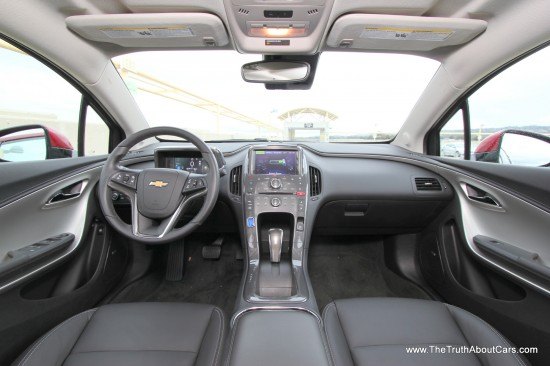Review: 2013 Chevrolet Volt (Video)

The Chevrolet Volt may be the most maligned and least understood car on the market. After a week of strange questions and bipolar reactions to GM’s plug-in hybrid, I came to a conclusion. GM’s marketing of the Volt stinks. By calling the Volt an “Electric Vehicle (EV) with a range extender,” a huge segment of the population can’t get past “Electric” and immediately cross the Volt off their list. There is also [strangely] a segment of the population that says, “that’s great but I want a hybrid.” Guess what? The Volt is a hybrid.
Exterior
Aerodynamics dictate the shape of modern high-efficiency cars, and as a result, the Volt has a profile very similar to the Honda Insight and Toyota Prius. Like the Japanese hybrids, the Volt is a liftback design which is more practical than your typical trunk lid for carrying large items from the home improvement store.
The Volt’s styling isn’t for everyone, but I find the overall style aggressive and attractive. There is a caveat. Since the shape is dictated by wind-tunnel testing (just like the Prius and Insight) the Volt reminds me of NASCAR cars. Why? Because they all have the same shape and teams paint / add decals to “brand” their car. The Volt/Prius/Insight reminds me of this tactic and parked next to one another in the dark you’d be hard pressed to differentiate them by silhouette.
For its first refresh since it launched as a 2011, GM decided to ditch the somewhat awkward black roof and black painted liftgate opting for a more harmonious body-matching hue. There are also subtle tweaks to the rear tail lamp modules this year.
Interior
Hybrids have long suffered cheaper looking and feeling interiors than their “normal” counterparts. That is true for the Prius, Insight and the Volt. The reason is two-fold. The first is obviously cost. Motors and batteries aren’t cheap and the Volt has 288 batteries jammed into a “T” shaped battery pack that runs the length of the car and across the back of the car behind the rear seats. With a nominal 16.5kWh capacity, this battery is about four times larger than the Prius Plug-In’s pack and nearly twice the size of Ford’s Energi. The second reason is weight. Hard plastics weigh less.
Hard plastics included, the Volt is a nicer place to spend your time than a Prius but Ford’s C-MAX takes top position in terms of interior parts feel. Style is subjective, but I would rank the Volt between the Prius’ funky interior design and the C-MAX’s mainstream interior. Part of this is because 2013 brings more sedate and mainstream choices to the Volt’s interior. Gone are the funky orange door panels with “circuit board” patterns replaced by a dark silver plastic panels on the black interior. New for 2013 is some brown love, a color combo that brings the Volt’s interior feel up a substantial notch without actually improving the quality of the plastics.
Front seat comfort slots between the Ford and Toyota alternatives up front, in the rear there is less headroom and legroom than in the Prius or C-MAX. There is also one less seat. The lack of a 5th seat seems to be a common reason given for choosing something else over the Volt, but the battery had to go somewhere so the Volt trades more cargo room with the seats in place vs the C-MAX Energi for that 5th seat. Pick your poison.
Infotainment & Gadgets
When it comes to infotainment and trendy gadgets, the Volt scores big. Sure the 7-inch LCD gauge cluster isn’t as snazzy as Land Rover’s 12-inch readout, but the Prius is stuck in a 1980s Chrysler LeBaron electrofluorescent-time-warp and one 7-inch readout trumps Ford’s twin-4.2″ display setup in my mind. That’s before I comment that the Volt’s gauges are where they belong, in front of the driver…
The Volt gets Chevy’s latest MyLink infotainment system with some slight tweaks for 2013. GM’s mid-market entertainment operating system is one of my favorites. The graphics are slick, the display is easy to read and GM offers a touchscreen and a joystick/knob controller so you can use whatever comes naturally. Unlike MyFord Touch and Cadillac’s CUE, the Chevy is virtually crash-free and always responsive. 2013 brings improved voice commands for your USB/iDevice allowing you to command your tunes at the press of a button, and unlike Toyota’s similar system, MyLink doesn’t have a problem with large music libraries. If you opt for nav software, destination entry is quick and the map software uses high-resolution maps with satellite traffic info.
On the safety gadget front 2013 brings collision and blind spot warning systems from the Cadillac XTS. The system is camera based so you can’t get radar adaptive cruise control, a system that is offered on the Prius and the Fusion Energi but not on the C-Max Energi.
Drivetrain
Before we dive into the Volt, it’s important to know how hybrid systems work. GM’s Belt-Alternator-Starter, Mercedes’ S400 Hybrid and Honda’s IMA hybrids are all systems where the engine is always connected and even if the car is capable of “EV” mode, the engine is spinning. Porsche, VW, Infiniti and others use a pancake motor and clutch setup to disconnect the engine from the motor and transmission allowing a “pure EV” mode. Honda’s new Accord has a 2-mode setup where the motor drives the wheels via a fixed ratio gearset, the engine drives a motor and above 45MPH a clutch engages, linking the engine and motor together at a ratio of roughly 1:1. Ford, Toyota and the Volt use a planetary gearset “power splitting” device. Yes, the Volt uses a hybrid system that although not identical, is thematically similar to Ford & Toyota’s hybrid system.
Say what? I thought GM said it was a serial hybrid? Yes, GM did at some point say that and I think that has caused more confusion than anything else about the Volt. The bankrupt Fisker Karma is only a serial hybrid. The engine drives a generator, the generator powers the battery and the motor to move the car forward. At no point can the engine provide any motive power to the wheels except via the electrical connection.
The Volt’s innovation is that it can operate like a Fisker Karma or like a Prius. It is therefore both a serial and a parallel hybrid. To do this, GM alters the power split device power flow VS the Ford/Toyota design. Then they add a clutch allowing the gasoline engine to be mechanically isolated from the wheels. And finally they add software with a whole new take on a hybrid system.
The Volt has four distinct operating modes.
- Starting off from a stop, the Volt draws power from its 16.5kWh (10.8 usable) battery pack to power the 149HP main motor.
- At higher speeds, the car will connect the 72HP secondary motor/generator via the planetary gearset. This is not to increase power, but to reduce the main motor’s RPM therefore increasing efficiency. Maximum horsepower is still 149.
When the battery is low, or when “hold” or “mountain modes are engaged, the system switches to one of two hybrid modes.
- The system starts the 1.4L 84 HP gasoline engine and uses it to turn a 72HP motor/generator. The system feeds the power to the battery and primary motor. Maximum horsepower is still 149. When more than 72HP is being consumed, the balance is drawn from the battery.
- When more power is required, the system disengages the clutch pack and the system functions very much like a Ford/Toyota hybrid with the gasoline engine assisting in the propulsion both mechanically and electrically via the power split device. Maximum horsepower is still 149 BUT this mode alters the torque curve of the combined system and in this mode acceleration is slightly faster than in any other mode.
Drive
Why do I mention the four modes? Because you can easily encounter all four modes in a single trip. Which mode the Volt uses is determined by the car, it is not user-selectable. Starting off at home with a full battery, I was able to drive 32 miles in EV mode. That’s about 22 more than the Prius Plug-In and 18 more than the C-MAX Energi. How is that possible with a battery that is so much larger? Allow me to digress for a moment.
GM takes an interesting and very conservative approach to battery life. Rather than charging and discharging the battery nearly completely as Nissan and Tesla’s EVs do, the Volt will only use the “middle” 65% of the battery. This means that when the display says it is “full,” the battery is really only 85% charged. When it reads empty, the true state of charge is around 35%. Why? Because batteries degrade more rapidly when they are at high or low states of charge. By never operating the battery at these extremes and having an active thermal management system, I expect the Volt’s battery to have a longer life than other vehicles on the market with the same battery chemistry.
Back to those modes. We clocked 0-60 in 8.72 seconds when the Volt was operating as an EV (slightly faster than the C-MAX Energi and much faster than a Prius). In parallel hybrid mode, the broader torque curve dropped this to 8.4 seconds. Transitions between modes is practically seamless unless you are driving the Volt aggressively on mountain roadways. On steep inclines when you’re at a lower state of charge, the Volt will switch from serial-hybrid to parallel-hybrid modes to keep from draining the battery below the minimum threshold. Transitioning from one mode to the other causes a momentary delay in power application as the transmission disengages the clutch pack and synchronizes the speeds of the motors and engine. This transition is more pronounced than a typical gear shift in a traditional automatic.
When it comes to road holding, the porky 3,899lb C-MAX Energi is the winner thanks to its wide 225-width rubber and the chassis’ Euro origins. The Volt is a close second at 3,781lbs with the standard 215 low rolling resistance rubber. The Prius? A distant third despite being the lightest at 3,165lbs. Admittedly handling better than a Prius isn’t a terribly high bar to leap, but in the grand scheme of things the Volt handles as well as the average compact sedan. Overall wind and road noise slot (yet again) between the quieter C-MAX and the noisier Prius.
Fuel economy is the most important part of a hybrid, and this is the area where the Volt starts having problems. Starting with a full battery (at my rates, this cost $1.52) the first 32 miles were in EV mode followed by 26 miles in hybrid mode. My average economy was 90 MPG, a few better than the Prius plug-in’s 72 on the same trip and 60 for the Ford. Being unable to charge the Volt at my office due to construction, these numbers fell rapidly on my way home. On this single-charge round trip, the Prius averaged 62 MPG, the C-MAX averaged 50 and the Volt dropped to 46. What’s going on? Once under way the Volt’s four-mode hybrid system seems to be less efficient than the C-MAX. The exact reasons for this I’m not sure, but on a round-trip commute without charging, I averaged 32-33 MPG vs the 40.7 in the C-MAX Energi and 52 in the Prius Plug-In. The longer you drive your Volt without charging it, the more it will cost to run than the Ford or Toyota.
On the flip side if your commute is within 30-35 miles of a charging station you will almost never use the gasoline engine. (The Volt will run it now and then to make sure the gasoline doesn’t go bad in the plumbing.) Unlike the alternatives, the Volt will also stay pure electric even under full throttle acceleration giving you a driving experience that is very much like a LEAF/Tesla until you deplete the battery.
This brings us full circle to the EV vs hybrid question. What is the Volt? In my opinion it’s a plug-in hybrid. I also think this is the best marketing angle for GM because when you explain to people that there is no range anxiety in the Volt and you can use the HOV lane in California solo, they seem to “get it.” The fly in the ointment is the price, The Volt starts at $39,145 and ends just shy of 45-large. The “that’s too much to pay for an electric Cruze” is a hard rep to shake, and even GM throwing cash on the Volt’s hood isn’t helping. Factor in the $8,000 premium over the C-MAX Energi and Prius Plug-In and you start to see the rest of the problem. At the end of my week with Chevy’s car with a plug I came to the conclusion that the Volt is the most misunderstood car on the market right now. But with a high sticker price and only four seats I’m not entirely sure that understanding GM’s conflicted EV/Hybrid will help them sell.
General Motors provided the vehicle, insurance and one tank of gas for this review
Specifications as tested
0-30: 3.285 Seconds (EV Mode)
0-60: 8.72 Seconds (EV Mode), 8.4 Seconds (hybrid mode)
1/4 Mile: 16.66 Seconds @ 84 MPH (EV Mode)
Average Observed Fuel Economy: 48MPG over 565 miles, 32-33MPG hybrid mode

More by Alex L. Dykes
Latest Car Reviews
Read moreLatest Product Reviews
Read moreRecent Comments
- Jeff Corey, Thanks again for this series on the Eldorado.
- AZFelix If I ever buy a GM product, this will be the one.
- IBx1 Everyone in the working class (if you’re not in the obscenely wealthy capital class and you perform work for money you’re working class) should unionize.
- Jrhurren Legend
- Ltcmgm78 Imagine the feeling of fulfillment he must have when he looks upon all the improvements to the Corvette over time!























































Comments
Join the conversation
The author does not understand the operation of the Two-motor vs. one motor mode. In the video he states that the small motor/generator "has to stop spinning in one direction ... then start spinning in the other direction". The ring gear that is driven by the small motor/generator comes to a complete stop and is then locked to the transmission case, while at the same time the small motor/generator is disconnected from the ring gear (and the engine while the transition is effected). As far as power to the road is concerned, that's it. Once one-motor mode is powering the car up the hill, the small motor/generator revs match the engine and the two are connected to provide power for the main motor. I don't believe the small motor actually changes direction between acting as a motor driving the ring gear and acting as a generator, since the engine always drives that motor/generator in the same direction, whether it's running as a generator or connected to the ring gear and providing torque. Anyway, it wouldn't matter if it did since the power to the wheels is already flowing from the main motor (powered from the battery) once the ring gear is locked, before the small motor/generator has to do anything about seeing to the needs of the battery and main motor.
GM has now had to drop the price on this LIE - TWICE! They would have been better making it a lease only. Now you can get one $0 down, $229/month. They should be flying off the lots but the lies from GM and owners have taken their toll. What lies? How about the method GM used to say the volt (i.e. DOLT) gets 287mpg? They filled the tank, drove 50 miles and measured how much gas was left. Forget the fact it was running on a separate power source for almost the entire 50 miles. The volt is the 21st century EDSEL.